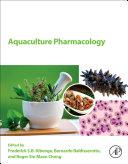Aquaculture Pharmacology

Akvakulturní farmakologie je spolehlivý, aktuální „all inclusive“ odkaz a průvodce, který poskytuje pochopení praktických informací o drogách pro odvětví akvakultury. Tato kniha pojednává o zdrojích, chemických vlastnostech a mechanismech působení léků a biologických systémech, na které působí. Pokrývá různé lékové interakce, terapeutické použití drog, jakož i právní úvahy v celém odvětví. Představuje čtyři hlavní skupiny drog používaných u ryb, korýšů a měkkýšů a zahrnuje dezinfekční prostředky, antimikrobiální léky, antiparazitika a anestetika a identifikuje oblasti, kde je zapotřebí dalšího výzkumu k získání více znalostí na podporu udržitelného odvětví akvakultury.
S narůstající mezinárodní expanzí v oblasti akvakultury a rozšiřováním globálního obchodu se živými vodními živočichy a jejich produkty je tato kniha užitečná pro bakteriology, mykology, akvakultury, klinické pracovníky v oblasti zdraví vodních živočichů a pro všechny v průmyslu, vládě nebo akademické sféře, kteří se zajímají o akvakulturu, rybolov a srovnávací biologie.
Klíčové vlastnosti
Představuje klinické informace pro tři hlavní vodní živočichy (ryby, korýši a měkkýši)
Usnadňuje výzkum vývoje vakcín nebo jiných podobných opatření ke zmírnění patogenů
Poskytuje nejnovější pokrok v této oblasti, včetně regulovaných léčiv pro použití v rybářství a akvakultuře
Aquaculture Pharmacology is a reliable, up-to-date, "all inclusive" reference and guide that provides an understanding of practical drug information for the aquaculture industry. This book covers the sources, chemical properties, and mechanisms of action of drugs, and the biological systems upon which they act. It covers various drug interactions, therapeutic uses of drugs, as well as legal considerations within the industry as a whole. It presents the four main groups of drugs used in fish, crustaceans and molluscs and includes disinfectants, antimicrobial drugs, antiparasitic agents, and anesthetics, and identifies areas where more research is needed to generate more knowledge to support a sustainable aquaculture industry.
With the burgeoning international aquaculture expansion and expanding global trade in live aquatic animals and their products this book is useful to bacteriologists, mycologists, aquaculturists, clinical practitioners in aquatic animal health and all those in industry, government or academia who are interested in aquaculture, fisheries and comparative biology.
Key Features
Presents clinical information for the three major aquatic food animals (fish, crustaceans and molluscs)
Facilitates research to develop vaccines or other similar pathogen mitigation measures
Provides the latest advancements in the field including regulated pharmaceuticals for use in fisheries and aquaculture
Readership
Researchers, teachers, students, diagnostic laboratory staff, clinical veterinarians, aquaculture disease practitioners, biologists, farmers, and all those in industry, government or academia who are interested in aquaculture, fisheries and comparative biology.
About the Editors
Frederick Kibenge
Dr. Fred Kibenge is Professor of Virology at the Atlantic Veterinary College, University of Prince Edward Island, Charlottetown, P.E.I, Canada, where he has been Chairman of the Department of Pathology and Microbiology for several years, and teaches veterinary virology in the second year of the DVM curriculum. He has been working with animal viruses for more than 30 years in addition to prior extensive post-doctoral research experience in virology in UK and USA. He is a Diplomate of the American College of Veterinary Microbiologists, ACVM (sub-specialty Immunology). He has published extensively on the detection and virology of fish viruses.
Affiliations and Expertise
Professor of Virology, Atlantic Veterinary College, University of Prince Edward Island, Charlottetown, PEI, Canada
Bernardo Baldisserotto
Bernardo Baldisserotto is a full professor in the Department of Physiology and Pharmacology at the Federal University of Santa Maria, Camobi campus. He has published five books on fish physiology and fish culture, and has organized and participated in numerous other books and journal publications. Dr. Baldisserotto is a member of the editorial board for Neotropical Ichthyology, and the part-time editor-in-chief for its Physiology and Biochemistry section.
Affiliations and Expertise
Full Professor, Department of Physiology and Pharmacology, Federal University of Santa Maria Camobi, Brazil
Roger Chong
Dr. Roger Sie-Maen CHONG is a veterinary specialist in Australia and the United Kingdom (UK), with expertise in fish and shellfish pathology as applied to the health and biosecurity of aquacultured species. He is officially registered as a specialist by the Queensland Board of Veterinary Surgeons for Veterinary Aquatic Animal Health (Australia) and by the Royal College of Veterinary Surgeons for Fish Health and Production (UK). He is also a certified Fish Pathologist recognized by the Fish Health Section of the American Fisheries Society. Dr. Chong has worked in Hong Kong with the Department of Agriculture, Fisheries & Conservation, in Queensland with the Biosecurity Queensland and is presently a research fish pathologist with the Australian Commonwealth Scientific and Industrial Research Organization (CSIRO).
Affiliations and Expertise
Registered Veterinary Specialist of Fish Health and Production, Royal College of Veterinary Surgeons, UK Registered Specialist of Veterinary Aquatic Animal Health, Queensland Veterinary Surgeons Board Australia Veterinary Aquatic Pathologist, Commonweallth Scientific and Industrial Research Organization (CSIRO), Australia
Autor: rederick Kibenge Bernardo Baldisserotto Roger Chong
| Nakladatel | Academic Press |
|---|---|
| ISBN | 9780128213391 |
| Vydání | 2020 |
| Vazba | brožovaná |
| Počet stran | 401 |
Table of Contents
1. Introduction to the anatomy and physiology of the major aquatic animal species in aquaculture
2. General Introduction to Pharmacology of Aquatic Animals
3. Antimicrobial Agents
4. Antiparasitic Agents
5. Probiotics, Prebiotics, Biofloc systems, and other Biocontrol Regimens in Fish and Shellfish Aquaculture
6. Gender Manipulators and Spawning Aids
7. Osmoregulators: Stress and disease in aquaculture, and their effects on homeostasis and osmoregulation: the metabolic connection
8. Analgesia Anaesthesia, and Euthanasia of Aquatic Animals
9. Legal Requirements for Aquaculture Pharmacology